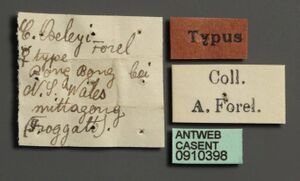Camponotus oxleyi
| Camponotus oxleyi | |
|---|---|

| |
| Scientific classification | |
| Kingdom: | Animalia |
| Phylum: | Arthropoda |
| Class: | Insecta |
| Order: | Hymenoptera |
| Family: | Formicidae |
| Subfamily: | Formicinae |
| Tribe: | Camponotini |
| Genus: | Camponotus |
| Species: | C. oxleyi |
| Binomial name | |
| Camponotus oxleyi Forel, 1902 | |
Identification
McArthur and Leys (2006) - Camponotus maculatus group species share the following distinguishing characters: 1. The most striking character is the distinct occipital carina in minor workers (see the dorsal head view of the minor worker in the caste images of Camponotus crozieri). This forms a ridge externally and probably serves to strengthen the anterior parts of the head (Snodgrass 1935), it is absent in major workers. 2. Strong dimorphism, i.e., workers encountered are mostly either major or minor, medium workers are non existent or very scarce. 3. The sides of the heads of major workers taper strongly to the front (Fig. 2) while in minor workers, the sides are mostly parallel and taper to the rear. 4. The vertex in major workers is concave or flat, in minor workers it is convex. 5. The scape and tibiae have plentiful short setae, raised up, more so in Australian than in African species. 6. Biology: (a) mostly nocturnal, (b) nests are at honey bait, (e) quickly scatter when disturbed by torch light.
Keys including this Species
Distribution
Distribution based on Regional Taxon Lists
Australasian Region: Australia (type locality).
Distribution based on AntMaps
Distribution based on AntWeb specimens
Check data from AntWeb
Countries Occupied
| Number of countries occupied by this species based on AntWiki Regional Taxon Lists. In general, fewer countries occupied indicates a narrower range, while more countries indicates a more widespread species. |

|
Estimated Abundance
| Relative abundance based on number of AntMaps records per species (this species within the purple bar). Fewer records (to the left) indicates a less abundant/encountered species while more records (to the right) indicates more abundant/encountered species. |

|
Biology
Castes
Images from AntWeb
   
| |
| Syntype of Camponotus oxleyi. Worker. Specimen code casent0910398. Photographer Z. Lieberman, uploaded by California Academy of Sciences. | Owned by MHNG, Geneva, Switzerland. |
Nomenclature
The following information is derived from Barry Bolton's Online Catalogue of the Ants of the World.
- oxleyi. Camponotus oxleyi Forel, 1902h: 501 (s.w.q.) AUSTRALIA (New South Wales).
- Type-material: syntype major and minor workers (numbers not stated).
- Type-locality: Australia: New South Wales, 86 mi. S Mittagong, Bong-Bong (W.W. Froggatt).
- Type-depositories: ANIC, MHNG.
- Combination in C. (Myrmocamelus): Forel, 1914a: 270;
- combination in C. (Myrmophyma): Emery, 1920b: 257.
- Status as species: Emery, 1925b: 112; Taylor & Brown, 1985: 118; Taylor, 1987a: 14; Bolton, 1995b: 116; McArthur, 2007a: 327; McArthur, 2014: 154.
- Distribution: Australia.
Type Material
- Syntype, 2 workers, Bong Bong, New South Wales, Australia, Musee d'Histoire Naturelle Genève.
- Syntype, 2 workers, Bong Bong, New South Wales, Australia, Museum Victoria, Melbourne.
Unless otherwise noted the text for the remainder of this section is reported from the publication that includes the original description.
Description
Worker major Length 9 to 12.5 mm. Mandibles short, thick, moderately curved, armed with 6 teeth, glossy, punctate,with a few striations. Clypeus with a feeble keel, without anterior lobe, anterior border tridented; the median indentation is a little less deep than the laterals but followed by a moderate impression in front of the keel. The sides of the clypeus diverge weakly. Frontal area distinct and frontal groove distinct. Frontal ridges sinuous, quite diverging. Head trapezoidal, moderately widened and excavated behind, sides moderately convex. Eyes a little in front of the posterior third. Three fossets in place of occelli. Scapes only slightly exceed the occiput. Thorax moderately convex from front to back, with the dorsum a little subbordered; anterior angles of the pronotum are edged. Pronotum is wider than long. Sutures glossy, strongly impressed. A distinct intermediary segment. Basal face of the metanotum (= propodeum) sub flat, in profile almost straight, 2.5 times longer than wide.
References
- Emery, C. 1920b. Le genre Camponotus Mayr. Nouvel essai de la subdivision en sous-genres. Rev. Zool. Afr. (Bruss.) 8: 229-260 (page 257, Combination in C. (Myrmophyma))
- Forel, A. 1902j. Fourmis nouvelles d'Australie. Rev. Suisse Zool. 10: 405-548 (page 501, soldier, worker, queen described)
- Forel, A. 1914a. Le genre Camponotus Mayr et les genres voisins. Rev. Suisse Zool. 22: 257-276 (page 270, Combination in C. (Myrmocamelus))
- McArthur, A. J. and R. Leys. 2006. A morphological and molecular study of some species in the Camponotus maculatus group (Hymenoptera: Formicidae) in Australia and Africa, with a description of a new Australian species. Myrmecologische Nachrichten. 8:99-110.
References based on Global Ant Biodiversity Informatics
- Forel A. 1902. Fourmis nouvelles d'Australie. Rev. Suisse Zool. 10: 405-548.
- Taylor R. W. 1987. A checklist of the ants of Australia, New Caledonia and New Zealand (Hymenoptera: Formicidae). CSIRO (Commonwealth Scientific and Industrial Research Organization) Division of Entomology Report 41: 1-92.

